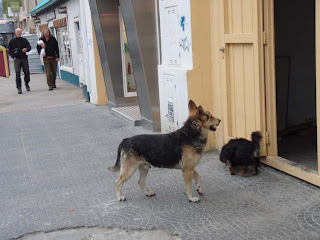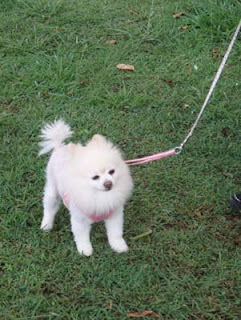I dog-sat a wonderful 9-month old mix-breed dog named Rocky last week. He is awfully cute and was extremely playful with every dog he met. I videotaped him interacting with other dogs. Below are eight short and fun video clips.
PLAY BITING
Here's a video of Rocky (the taller one with black muzzle) playing with a 7-month old puppy named Natto. They're both young, energetic boys. Notice the soft mouthing and play bows. Very nice!
In the next clip, Rocky is playing with a 1+ year old female shepherd mix named Marley. The playing style is a little different from the video above of Rocky and Natto although they are also play-biting each other's necks. Notice the bite inhibition - they never bite too hard. When dogs are playing, they will often pause, and then continue their play. In this video you'll see Rocky shaking off at the end, a sign that he's coming down off of adrenaline.
WRESTLING AND PAWING
Here we have Rocky playing with Marley again. They wrestle a little and use their paws to paw at each other. Dogs at play will often take turns being on the bottom, or being the prey versus predator.
STALK-N-POUNCE
In the next clip you'll see Rocky stalking my golden retriever Luka, and then pouncing. Dogs often use hunting behavior in play. Ruby the 10-week old puppy also tries to engage Luka by play bowing and growling. Luka is an older dog (almost 8) so he's not interested in playing with the young dogs!
KEEP AWAY
Dogs love to play "keep away" where they grab a toy and keep it away from another dog or a person and be chased. Here's Marley keeping a rawhide bone away from Rocky.
Below we have Rocky keeping a rope toy away from a 10-week old puppy named Ruby. Rocky is very playful with Ruby, and doesn't guard the toy when she takes it away.
PUPPY LICKING
In the next video, Marley keeps the rawhide away from Rocky again. When Rocky attempts to approach the rawhide, Marley makes a playful but sudden movement as if to say, "Mine!" Rocky backs off, and then appeases Marley by licking her muzzle. "Puppy licking" can also be a sign of bonding.
BONUS VIDEO - SIT STAY
Here we have Rocky, Luka and 7 year old German Shepherd Vader doing sit-stays. Rocky is young and new to the sit-stay, so he attempts to get up once. I use my body to put Rocky back in his original position. They all get rewarded in the end for maintaining their sit-stay.
Wednesday, June 24, 2009
Friday, June 19, 2009
The Importance of Early Socialization
It's quite common for dogs to become averse to certain things. Occasionally the aversions turn into full-blown fears or fear-based aggression. It's not fun for your dog, and it's not fun for the dog owner. Exposing your dog to many things from an early age can help to prevent this problem. Some common things you will want to expose your puppy to include:
* People - men, women, children, babies
* Other dogs
* Cats and other animals
* Riding in cars
* Going to the vet
* Nail clipping
* Bathing
* Swimming
* Stairs (including ones you can see through)
* Crates
* Being alone
* Loud noises including fireworks and thunder
* Bicycles, skateboards, scooters
* Public places and crowds
* Walking on a leash
When exposing your dog to these things, it's important to make it a positive experience. For instance, you might give Fido his favorite treat or give him a massage while you clip his nails so that he thinks of nail clipping as a happy event. If Fido is naturally fearful of certain things from the get go, you will want to introduce him to those things slowly or in increments.
It's especially important for puppies to be socialized with other dogs and people (strangers). Puppies go through a critical period of socialization between 1 to 4 months of age. If isolated from the outside world during that time, they can grow up to be unbalanced adult dogs. Some veterinarians advise people to keep their puppies in the yard or home until the entire vaccination series are complete. Of course, you should complete the first set of vaccines and keep your pup away from high-risk areas, but did you know that the chance of a dog being euthanized for behavioral problems is 1000 times higher than a dog getting sick from parvovirus or distemper?
It's also true that dogs, especially young ones, can be easily traumatized by a single negative experience with another dog. So it's very important that you monitor your dog's interactions with other dogs, and that you don't put your dog in a position where he has to defend himself. Dog parks are great, but as your dog's guardian, it's a good idea to educate yourself on subtle dog behaviors and always keep an eye on your dog, so that you can prevent bullying and fighting.
It's always easier to take precautionary measures to prevent fear, than to counter-condition a dog that has developed a negative emotional response towards something. Trust me on this one - early socialization is well worth your time!
* People - men, women, children, babies
* Other dogs
* Cats and other animals
* Riding in cars
* Going to the vet
* Nail clipping
* Bathing
* Swimming
* Stairs (including ones you can see through)
* Crates
* Being alone
* Loud noises including fireworks and thunder
* Bicycles, skateboards, scooters
* Public places and crowds
* Walking on a leash
When exposing your dog to these things, it's important to make it a positive experience. For instance, you might give Fido his favorite treat or give him a massage while you clip his nails so that he thinks of nail clipping as a happy event. If Fido is naturally fearful of certain things from the get go, you will want to introduce him to those things slowly or in increments.
It's especially important for puppies to be socialized with other dogs and people (strangers). Puppies go through a critical period of socialization between 1 to 4 months of age. If isolated from the outside world during that time, they can grow up to be unbalanced adult dogs. Some veterinarians advise people to keep their puppies in the yard or home until the entire vaccination series are complete. Of course, you should complete the first set of vaccines and keep your pup away from high-risk areas, but did you know that the chance of a dog being euthanized for behavioral problems is 1000 times higher than a dog getting sick from parvovirus or distemper?
It's also true that dogs, especially young ones, can be easily traumatized by a single negative experience with another dog. So it's very important that you monitor your dog's interactions with other dogs, and that you don't put your dog in a position where he has to defend himself. Dog parks are great, but as your dog's guardian, it's a good idea to educate yourself on subtle dog behaviors and always keep an eye on your dog, so that you can prevent bullying and fighting.
It's always easier to take precautionary measures to prevent fear, than to counter-condition a dog that has developed a negative emotional response towards something. Trust me on this one - early socialization is well worth your time!
Tuesday, June 9, 2009
Argentinian Hounds
 I visited Buenos Aires, Argentina for the first time in December 2008. The food was amazing and we loved the people and the European feel of the cafés. But what struck me the most in Buenos Aires were the dog walkers. While sightseeing in the city, I saw many dog walkers walking up to ten dogs at a time! And what was even more amazing was that the dogs were all perfectly calm, no matter what they saw around them! Not one of them was pulling on the leash.
I visited Buenos Aires, Argentina for the first time in December 2008. The food was amazing and we loved the people and the European feel of the cafés. But what struck me the most in Buenos Aires were the dog walkers. While sightseeing in the city, I saw many dog walkers walking up to ten dogs at a time! And what was even more amazing was that the dogs were all perfectly calm, no matter what they saw around them! Not one of them was pulling on the leash.As a dog trainer in Hawaii, I meet many troubled dog owners who get walked by their dogs instead of them walking their dogs. Pulling on the leash and over-excitement are pretty common issues with dogs in the United States. How was it possible that the Buenos Aires dogs were so calm? I could be completely wrong but my theory is:
1. The dogs in Buenos Aires get out of the house and get walked more than their American counterparts.
2. They get to be around other dogs more often so it's not such a novelty to see another dog.
3. Argentinians treat their dogs like dogs, and they don't reinforce the dogs' excited behavior with attention.
Below: A makeshift dog park in the city center.
There were a lot of stray dogs in Ushuaia, the southernmost town in Argentina. What was interesting about the stray dogs there was that they all had long hair. Most stray dogs I've seen in Hawaii are short haired. I don't know if it's a case of "survival of the fittest," where long-haired dogs are more likely to survive in the cold climate of Ushuaia, or if there are more long-haired pet dogs over there in general, and therefore more long-haired strays.
Below: Stray dogs of Ushuaia.

5th Annual Hawaii Kai Dog Walk
Below: The registration booth
 Below: Hundreds of dogs and their humans participated in this fun walk to raise funds for Hui 'Ilio.
Below: Hundreds of dogs and their humans participated in this fun walk to raise funds for Hui 'Ilio. Hui 'Ilio Hawai'i (the Hawaii Dog Group) was founded to promote safe and friendly places for dogs and their people to play, and to promote responsible dog ownership. Their initial reason for organizing was to establish the Hawaii Kai Dog Park.
Hui 'Ilio Hawai'i (the Hawaii Dog Group) was founded to promote safe and friendly places for dogs and their people to play, and to promote responsible dog ownership. Their initial reason for organizing was to establish the Hawaii Kai Dog Park.Below: The 2.3 mile walk was a bit long for some of the smaller dogs but they seemed to enjoy it anyway.

I participated in their 5th annual dog walk fundraiser on June 7th, 2009. It was exciting to be around so many dogs, from tiny Pomeranians to huge Great Danes. It was amazing how well-behaved all the dogs were. The event was very well organized, with prizes, goodie bags, T-shirts, and booths offering dog-related information. There were lots of volunteers throughout the walking trail, providing water for the dogs and directing traffic. The Hawaii Kai Dog Walk is definitely a model to follow when it's time for the North Shore to hold a fundraiser for our dog park.
Below: They must be from the Great Dane Club of Hawaii!

Now that the Hawaii Kai dog park is a reality, Hui 'Ilio's ongoing goals include helping other dog groups (like us) get approval for parks in their respective districts, enhancing the opportunities for dogs to get proper exercise and socialization, and promoting the licensing, vaccination, and good-behavior training of dogs.
Below: Not surprisingly, all the Labradors gravitated towards the swimming pool.

Labels:
dog park,
dog walk,
fundraiser,
Hawaii Kai,
Hui 'Ilio
Subscribe to:
Posts (Atom)